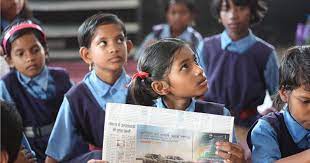Education is the cornerstone of progress and when it comes to Women’s Education, the stakes are even higher. Women’s Education refers to the acquisition of knowledge and skills by Girls and Women that enables them to realise their full potential and lead more fulfilling lives. In India, Women’s Education has come a long way since the Colonial Era, but there is still a long way to go. Historically, Women’s Education was seen as a luxury and not a necessity. It was only in the 19th and 20th centuries that a few pioneering Women like Pandita Ramabai and Savitribai Phule challenged the norms and paved the way for the Education of Women. Today, the importance of Women’s Education cannot be overstated. Educating Women not only empowers them but also has a ripple effect on their families, communities and the country as a whole. According to the 2011 Census, the literacy rate of Women in India is 65.46%, which is lower than the global average. Therefore, the need for promoting and enhancing Women’s Education in India is more critical than ever.
Status of Women’s Education in India
Despite progress in recent years, the literacy rate for Women in India is still lower than that of men. According to the 2011 Census, the literacy rate of Women in India is 65.46%, while the male literacy rate is 82.14%. This gender gap in literacy is even more pronounced in rural areas, where the female literacy rate is only 57.93%, compared to the male literacy rate of 77.15%.
Only 66.5% of Girls in India complete primary school and only 40.3% complete secondary school.
In some parts of India, Girls are 50% more likely to drop out of school than boys.
In rural India, only 1 in 100 Girls reaches class 12, compared to 7 in 10 boys.
These statistics and challenges highlight the urgent need to address the issue of Women’s Education in India and promote equal opportunities for Girls and Women.
Challenges of Women’s Education in India
Several factors contribute to the low literacy rate of Women in India. Few of them are as follows –
Poverty
Poverty is a significant obstacle to Education in India and many families cannot afford to send their daughters to school. Families in rural areas, where poverty rates are higher, may prioritise their sons’ Education over their daughters’ Education. Furthermore, the indirect costs of Education, such as transportation and textbooks, can also be a burden for poor families.
Child marriage
Child marriage is still prevalent in some parts of India, particularly in rural areas. When Girls are married off at a young age, they are often forced to drop out of school and take on household responsibilities. Child marriage is a violation of Girls’ rights and perpetuates the cycle of poverty, illiteracy and poor health.
Societal norms and Gender Stereotypes
Despite progress in recent years, societal norms and gender stereotypes still limit Girls’ access to Education in India. Many families still view Education as unnecessary for Girls, particularly in rural areas where traditional gender roles are strongly entrenched. Girls may be expected to prioritise domestic duties or care for younger siblings instead of attending school. Additionally, Girls who do attend school may face gender-based discrimination from teachers and peers.
Importance of Women’s Education in India
Investing in Women’s Education in India can have far-reaching benefits for individuals, families and communities. Promoting Girls’ Education and ensuring equal opportunities for Women is not only a matter of human rights, but also an essential step towards sustainable development and progress.
Empowerment of Women
Educated Women are more likely to participate in political activities and challenge gender-based discrimination and violence.
Education is a powerful tool for empowering Women and enabling them to take control of their lives. Education helps Women develop critical thinking skills, build confidence and make informed decisions about their health, career and family. Educated Women are more likely to participate in the workforce, have better earning potential and have greater social mobility. Additionally, educated Women are more likely to have a say in household and community decisions and can advocate for their own rights and the rights of others.
Reduction in Poverty and Overpopulation
Educated Women are more likely to have smaller families and fertility rates are lower among educated Women in India.
Women’s Education can also contribute to reducing poverty and overpopulation. Educated Women are more likely to delay marriage and childbearing, which can lead to smaller families and reduce the strain on resources. Furthermore, educated Women are more likely to participate in the workforce and contribute to the economy, which can help lift families out of poverty and improve living standards.
Better Health
Studies have shown that Women’s Education is linked to reduced maternal mortality rates and improved child health outcomes in India.
Women’s Education is also linked to better health outcomes. Educated Women are more likely to have access to health information and resources and are more likely to seek medical care when needed. Furthermore, educated Women are better equipped to make informed decisions about their health and the health of their families, leading to better health outcomes for all.
Social and Cultural Progress
Women’s Education is also crucial for social and cultural progress. Educated Women can challenge harmful gender norms and stereotypes and advocate for gender equality and Women’s rights. Additionally, educated Women are more likely to be involved in community and civic activities, leading to greater social cohesion and progress.
Ways to Promote Women’s Education in India
Government Initiatives
The government of India has implemented several initiatives to promote Women’s Education in the country. These initiatives include-
- Beti Bachao, Beti Padhao- This is a national campaign launched in 2015 to improve the status of Girls and Women in India by promoting their Education and empowerment.
- Sarva Shiksha Abhiyan– This is a flagship government program launched in 2001 to ensure universal elementary Education in India. The program aims to provide free and compulsory Education to all children aged 6-14 years, with a special focus on Girls and children from marginalised communities.Sarva Shiksha Abhiyan have led to a significant increase in the enrollment of Girls in schools across the country.
- Rashtriya Madhyamik Shiksha Abhiyan– This is a government program launched in 2009 to improve access to and quality of secondary Education in India. The program aims to provide universal access to secondary Education by 2020, with a special focus on Girls and children from marginalised communities.
NGOs and Private Organisations
Non-governmental organisations (NGOs) and private organisations also play a critical role in promoting Women’s Education in India. These organisations work towards improving access to Education, providing scholarships and financial assistance to Girls and promoting awareness about the importance of Education for Girls. Some prominent NGOs and private organisations working in this field include-
- Pratham– This is an NGO that focuses on improving access to Education for children in India, with a special focus on Girls and children from marginalised communities.NGOs like Pratham have successfully implemented innovative programs like the “Read India” campaign to improve literacy levels among children in India.
- Nanhi Kali– This is an initiative launched by the Mahindra Group in partnership with the Naandi Foundation to provide Education and support to underprivileged Girls in India.
- Azim Premji Foundation– This is a foundation that works towards improving Education outcomes in India, with a special focus on Girls and children from marginalised communities.
Role of Society and Individuals
Finally, promoting Women’s Education in India also requires the involvement of society and individuals. This can be done by-
- Challenging gender stereotypes and promoting the idea that Education is equally important for Girls and boys.
- Encouraging Girls to pursue their Education and supporting them financially and emotionally.
- Supporting Women’s Education initiatives in their local communities and advocating for policies and programs that promote Women’s Education.
We have discussed the status of Women’s Education in India, the importance of Women’s Education for empowerment, poverty reduction, better health and social progress and the ways to promote Women’s Education in India.
It is crucial that we take action to promote Women’s Education in India. We must support government initiatives, NGOs and private organisations that work towards this goal and we must challenge societal norms and gender stereotypes that limit Girls’ access to Education.
Education is a fundamental right and every Girl in India deserves the opportunity to learn, grow and reach her full potential. By promoting Women’s Education in India, we can build a more equal and just society for all.
Remember, educating Girls is not just the responsibility of the government or NGOs, but it is also the responsibility of every individual in society. Together, we can create a future where every Girl in India has access to quality Education and the opportunity to realise her dreams.



